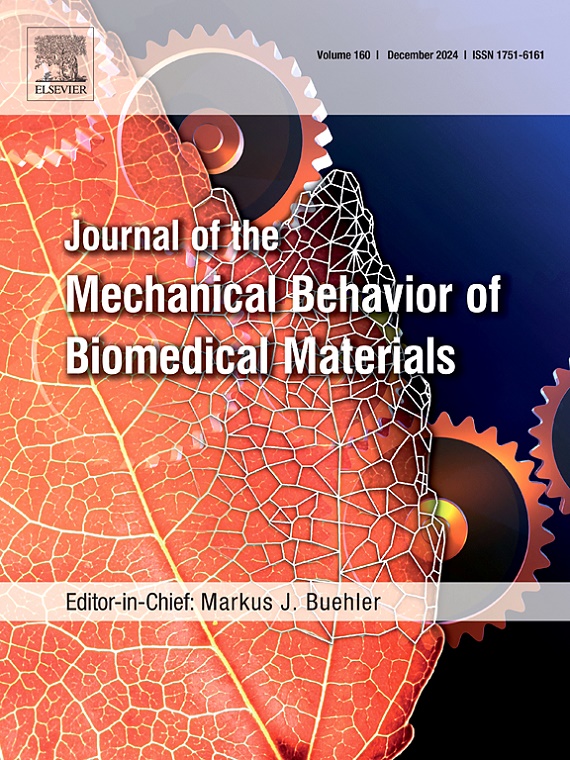Indentation size effect in Knoop and Vickers hardness measurement of dental resin-based composites
IF 3.3
2区 医学
Q2 ENGINEERING, BIOMEDICAL
Journal of the Mechanical Behavior of Biomedical Materials
Pub Date : 2024-11-19
DOI:10.1016/j.jmbbm.2024.106823
引用次数: 0
Abstract
Objectives
Comparisons of material hardness may be affected by the indentation size effect (ISE), which is characterized by increasing hardness values at decreasing loads. This study aimed to assess the influence of load, dwell time and measurement method on ISE in dental resin-based composites with different filler content.
Methods
Knoop (HK) and Vickers (HV) microindentation hardness of Filtek Ultimate Universal Restorative (FU) and Filtek Supreme Flowable Restorative (FF) was measured under different loads (0.098–2.96 N, i.e. 10-300 gf) and dwell times (5–30 s). Their effects on HK and HV were evaluated using repeated measures ANOVA, which was also used to compare the measurement methods. Coefficients of Meyer's equation, proportional specimen resistance (PSR) model and a modified PSR model were calculated using regression analyses.
Results
ISE was more pronounced for the highly-filled FU than for the less-filled FF, and HK was more susceptible to ISE than HV. The effect of dwell time was similar for both materials and measurement methods; hardness values decreased with dwell time, significantly between 5 s and 30 s.
Significance
The possible presence of ISE should be considered when determining measurement conditions for the microindentation hardness of dental resin-based composites. HV was found to be less sensitive to ISE and provided stable hardness values at lower loads than HK. Due to the high variability of composites, any hardness measurement should be preceded by mapping the effect of load to ensure that load-independent hardness is measured. If hardness values continue to decrease in the whole range of increasing loads, load-independent hardness can be calculated using the PSR model.
牙科树脂基复合材料努氏和维氏硬度测量中的压痕尺寸效应
目的:材料硬度的比较可能会受到压痕大小效应(ISE)的影响,这种效应的特点是在载荷减小的情况下硬度值增加。本研究旨在评估不同填料含量的牙科树脂基复合材料的载荷、停留时间和测量方法对 ISE 的影响:方法:在不同载荷(0.098-2.96 N,即 10-300 gf)和停留时间(5-30 s)下测量 Filtek Ultimate Universal Restorative (FU) 和 Filtek Supreme Flowable Restorative (FF) 的努氏(HK)和维氏(HV)微压痕硬度。使用重复测量方差分析评估了它们对 HK 和 HV 的影响,该方差分析也用于比较各种测量方法。使用回归分析计算了迈耶方程、试样电阻比例模型和修正的试样电阻比例模型的系数:高填充 FU 的 ISE 比低填充 FF 更明显,HK 比 HV 更容易受到 ISE 的影响。停留时间对两种材料和测量方法的影响相似;硬度值随停留时间而降低,在 5 秒至 30 秒之间显著降低:意义:在确定牙科树脂基复合材料微压痕硬度的测量条件时,应考虑可能存在的 ISE。与 HK 相比,HV 对 ISE 的敏感性较低,在较低负载下可提供稳定的硬度值。由于复合材料的变异性很大,因此在测量硬度之前应先绘制载荷效应图,以确保测量的硬度与载荷无关。如果硬度值在载荷增加的整个范围内持续下降,则可使用 PSR 模型计算与载荷无关的硬度。
本文章由计算机程序翻译,如有差异,请以英文原文为准。
求助全文
约1分钟内获得全文
求助全文
来源期刊

Journal of the Mechanical Behavior of Biomedical Materials
工程技术-材料科学:生物材料
CiteScore
7.20
自引率
7.70%
发文量
505
审稿时长
46 days
期刊介绍:
The Journal of the Mechanical Behavior of Biomedical Materials is concerned with the mechanical deformation, damage and failure under applied forces, of biological material (at the tissue, cellular and molecular levels) and of biomaterials, i.e. those materials which are designed to mimic or replace biological materials.
The primary focus of the journal is the synthesis of materials science, biology, and medical and dental science. Reports of fundamental scientific investigations are welcome, as are articles concerned with the practical application of materials in medical devices. Both experimental and theoretical work is of interest; theoretical papers will normally include comparison of predictions with experimental data, though we recognize that this may not always be appropriate. The journal also publishes technical notes concerned with emerging experimental or theoretical techniques, letters to the editor and, by invitation, review articles and papers describing existing techniques for the benefit of an interdisciplinary readership.
 求助内容:
求助内容: 应助结果提醒方式:
应助结果提醒方式:


